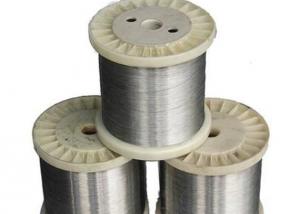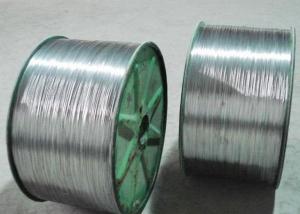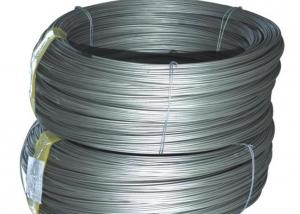430 Stainless Steel Wire
- Loading Port:
- China Main Port
- Payment Terms:
- TT or LC
- Min Order Qty:
- 1 Ton m.t.
- Supply Capability:
- 2000 Tons Per Month m.t./month
OKorder Service Pledge
OKorder Financial Service
You Might Also Like
Stainless Steel Wire
1.Grade: SS 200,300,400 series
2.Dia: 0.1mm-100mm
3.Length:500m-2000m/Reel
4.Surface: Bright
5.Certificate: Fortune 500, SGS, ISO 9001:2008
6.Test: Salt Spray over200 hours
7.MOQ:500kg
8.Delivery: Within 20 days
9.Packing: Reel, wooden box or according to your requirement
10.Payment terms: China Main Port or CIF ANY PORT
11. Application: Tie wire, pins, lashing, forming wire, filters, gaskets, elevators, safety wire, shaped and flat wire, conveyors, jewelry, springs, brush welding, electrical, wire line, craft and many more applications.
|
Main Grades |
C % |
Si % |
S % |
P % |
Mn % |
Cr % |
Ni % |
Mo % |
Cu % |
|
S30400 |
<0.08 |
<0.75 |
<0.015 |
<0.045 |
<2 |
18.05-19 |
8.01--8.25 |
<0.6 | |
|
304H |
0.04-0.1 |
<0.75 |
<0.015 |
<0.045 |
<2 |
18.05-19 |
8.01--8.25 |
<0.5 | |
|
304Hc1 |
0.03-0.05 |
<0.75 |
<0.015 |
<0.045 |
<2 |
18.05-19 |
8.01-8.25 |
1.2-1.6 | |
|
304Hc |
0.03-0.05 |
<0.75 |
<0.015 |
<0.045 |
<2 |
18.05-19 |
8.01--8.25 |
2-3 | |
|
304Hc3 |
0.03-0.05 |
<0.75 |
<0.015 |
<0.045 |
<2 |
18.05-19 |
8.01--8.25 |
3-3.5 | |
|
304ES |
<0.08 |
<0.75 |
<0.015 |
<0.045 |
2-3 |
16.05-17 |
6.01-6.3 |
1.5-3 | |
|
304M2 |
0.05-0.08 |
<0.75 |
<0.015 |
<0.045 |
2-3 |
18-18.5 |
7-8.1 |
<0.6 | |
|
304M3 |
0.05-0.08 |
<0.75 |
<0.015 |
<0.045 |
2-3 |
18-18.5 |
8.01-8.25 |
<0.6 | |
|
304L |
<0.035 |
<0.75 |
<0.015 |
<0.045 |
<2 |
18.05-19 |
8.01--8.25 |
<0.6 | |
|
321 |
0.04-0.08 |
<0.75 |
<0.015 |
<0.045 |
<2 |
17-18 |
8.01--8.25 |
||
|
316L |
<0.035 |
<0.75 |
<0.015 |
<0.045 |
<2 |
16.05-17 |
10.01--10.35 |
2.01-2.2 |
<1 |
|
316 |
0.04-0.08 |
<0.75 |
<0.015 |
<0.045 |
<2 |
16.05-17 |
10.01--10.35 |
2.01-2.2 |
<1 |
|
316LCu |
<0.035 |
<0.75 |
<0.05 |
<0.045 |
<2 |
16-17 |
10-10.5 |
2-2.25 |
|
|
ER316L |
<0.04 |
0.65 |
<0.03 |
<0.04 |
1.0-2.5 |
18-20 |
11.1-12 |
||
|
201CU |
<0.08 |
<0.75 |
<0.015 |
<0.045 |
8-9.5 |
13.05-14 |
4.01-4.25 |
2-3 | |
|
D667 |
<0.08 |
<0.75 |
<0.015 |
<0.045 |
13-14 |
13-14 |
0.7-1.5 |
1.5-3 | |
|
D665B |
<0.08 |
<0.75 |
<0.015 |
<0.045 |
14-16 |
10.05-11 |
<1.2 |
0.5--1.5 | |
|
202B |
0.1-0.15 |
<0.75 |
<0.015 |
<0.045 |
9-10 |
17.05-18 |
4.5-5 |
||
|
D669 |
0.08-1.0 |
<0.75 |
<0.015 |
<0.045 |
14.5-16 |
11-12 |
<1.2 |
0.5-1.5 | |
|
200CU |
<0.08 |
<0.75 |
<0.015 |
<0.045 |
11-12 |
13-14 |
1-2 |
1.5-2.5 |
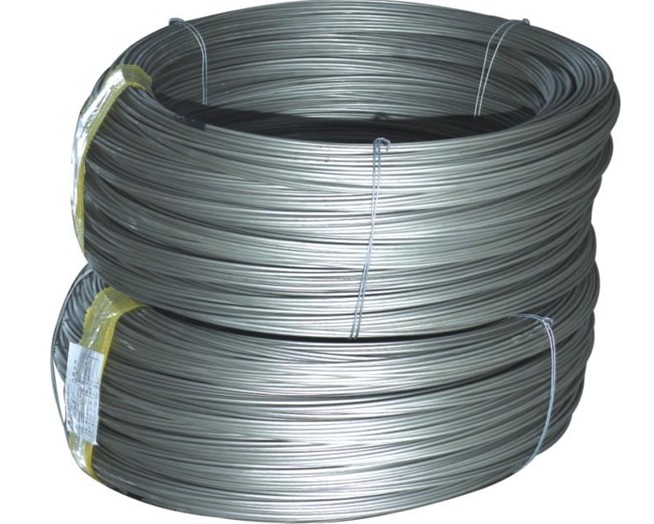
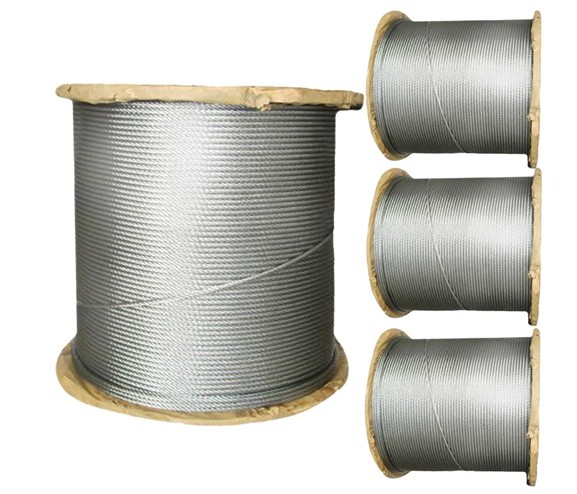
- Q:What are the applications of stainless steel wire?
- Stainless steel wire has a wide range of applications due to its unique properties and characteristics. Here are some of the main applications: 1. Industrial and Construction: Stainless steel wire is extensively used in various industrial sectors, such as construction, automotive, aerospace, and marine industries. It is used for manufacturing high-strength components, structural parts, springs, fasteners, and wire ropes. 2. Medical and Surgical Instruments: Stainless steel wire is widely used in the medical field for manufacturing surgical instruments, orthopedic implants, and medical device components. Its corrosion resistance, biocompatibility, and strength make it an ideal material for these applications. 3. Filtration and Sieving: Stainless steel wire mesh is commonly used in filtration and sieving processes. It is used for making filters, sieves, screens, and strainers in industries such as food processing, pharmaceuticals, mining, and water treatment. 4. Jewelry and Fashion Accessories: Stainless steel wire is increasingly being used in the jewelry industry due to its durability, resistance to tarnish, and affordability. It is used to make various jewelry items like rings, bracelets, necklaces, and earrings. 5. Electrical and Electronics: Stainless steel wire is used in electrical and electronic applications, including wiring, connectors, heating elements, and resistors. Its high electrical conductivity and resistance to corrosion make it a suitable material for these purposes. 6. Art and Craft: Stainless steel wire is also used by artists and craftsmen for creating sculptures, wire art, and decorative items. Its strength, malleability, and ability to retain shape make it an excellent medium for artistic expression. 7. Automotive and Transportation: Stainless steel wire is used in the automotive and transportation industry for various purposes like springs, cables, brake wires, and exhaust systems. Its high strength and resistance to corrosion and heat make it suitable for these applications. 8. Agriculture and Horticulture: Stainless steel wire is commonly used in the agricultural and horticultural sectors for applications like vineyard trellising, plant support structures, and fencing. Its durability and resistance to rust and weather conditions make it ideal for these uses. Overall, stainless steel wire's versatility, strength, corrosion resistance, and aesthetic appeal make it a valuable material in a wide range of applications across different industries.
- Q:Is stainless steel wire suitable for welding electrodes?
- Indeed, welding electrodes can be made from stainless steel wire. Stainless steel possesses remarkable attributes such as exceptional strength, resistance to corrosion, and tolerance to high temperatures, rendering it an optimal selection for welding purposes. Diverse welding techniques, including shielded metal arc welding (SMAW), gas tungsten arc welding (GTAW), and gas metal arc welding (GMAW), frequently incorporate stainless steel electrodes. Such electrodes guarantee a steady and accurate arc while welding, giving rise to robust and enduring welds. Moreover, stainless steel electrodes exhibit commendable weldability, enabling effortless handling and regulation throughout the welding procedure.
- Q:Can stainless steel wire be coated or plated with other materials?
- Coating or plating stainless steel wire with other materials is a widespread practice across various industries like automotive, aerospace, and electronics. The objective is often to improve the wire's properties, such as corrosion resistance, conductivity, or appearance. Zinc, nickel, chrome, copper, and various alloys are commonly used materials for this purpose. To achieve this, a thin layer of the desired material is applied onto the wire's surface through techniques like electroplating, electroless plating, or other coating methods. This enables the creation of a protective layer or the addition of specific properties while maintaining the stainless steel wire's inherent strength and durability.
- Q:How is stainless steel wire different from galvanized wire?
- Stainless steel wire and galvanized wire are two distinct wire types, each possessing unique properties and characteristics. The dissimilarities between them can be found in their composition, corrosion resistance, and applications. Regarding composition, stainless steel wire consists of a steel alloy, chromium, and sometimes additional elements like nickel or molybdenum. This composition grants stainless steel wire exceptional strength, durability, and resistance against corrosion. Conversely, galvanized wire is composed of carbon steel wire coated with a layer of zinc. This zinc coating shields galvanized wire from rust and corrosion. In terms of corrosion resistance, stainless steel wire exhibits high resistance, rendering it suitable for various outdoor applications and harsh environments. It can withstand exposure to moisture, chemicals, and extreme temperatures without compromising its integrity. On the other hand, galvanized wire, though offering some corrosion resistance due to its zinc coating, is not as resilient as stainless steel wire. Over time, the zinc coating may wear off, leaving the underlying steel susceptible to rust and corrosion. Concerning applications, stainless steel wire finds common usage in industries such as construction, marine, automotive, and aerospace. Its superior corrosion resistance and strength make it ideal for applications requiring high durability, such as fencing, springs, cables, and wires utilized in surgical instruments or food processing equipment. Conversely, galvanized wire is often employed in applications where corrosion resistance is not the primary concern. It is commonly used in wire mesh, binding or tying material, or in the construction of fences and cages. To summarize, stainless steel wire and galvanized wire differ significantly in terms of composition, corrosion resistance, and applications. While stainless steel wire is renowned for its exceptional strength and resistance against corrosion, galvanized wire offers some corrosion resistance but is not as durable or long-lasting as stainless steel wire. The choice between these two wire types depends on the specific requirements of the intended application.
- Q:Does stainless steel wire have magnetic properties?
- Stainless steel wire possesses magnetic properties, yet the degree of magnetism may differ based on the particular composition of the stainless steel alloy. Austenitic stainless steels, the most prevalent type, are typically regarded as non-magnetic. This is due to their high levels of nickel and chromium, which establish a robust passive oxide layer on the surface, preventing magnetism. Conversely, ferritic and martensitic stainless steels, with higher iron content, can display magnetic properties. Consequently, when assessing the magnetic behavior of stainless steel wire, it is crucial to consider the specific alloy type and composition.
- Q:Can stainless steel wire be used for heat exchangers?
- Yes, stainless steel wire can be used for heat exchangers. Stainless steel is a popular choice for heat exchangers due to its high corrosion resistance, excellent heat transfer properties, and durability. Stainless steel wire can be formed into various shapes and designs to suit the specific requirements of heat exchangers. Additionally, stainless steel is known for its ability to withstand high temperatures, making it suitable for applications where heat transfer is involved. Overall, the use of stainless steel wire in heat exchangers ensures efficient heat transfer, longevity, and resistance to corrosion.
- Q:Is stainless steel wire resistant to acids?
- Yes, stainless steel wire is generally resistant to acids. Stainless steel is an alloy that contains chromium, which forms a protective layer on the surface when exposed to oxygen. This layer, called chromium oxide, acts as a barrier against corrosion and prevents the acid from reaching the underlying metal. However, the resistance of stainless steel wire to acids can vary depending on the specific grade and concentration of the acid. In highly corrosive environments or with strong acids, it is recommended to use stainless steel wire with higher levels of corrosion resistance, such as those with higher chromium and nickel content, to ensure optimal performance.
- Q:Is stainless steel wire suitable for wire rope fittings?
- Yes, stainless steel wire is suitable for wire rope fittings. Stainless steel wire is known for its strength, durability, and resistance to corrosion. These qualities make it an excellent choice for wire rope fittings, as they need to withstand heavy loads and adverse environmental conditions. Stainless steel wire rope fittings also offer excellent flexibility, allowing for easy installation and adjustment. Additionally, stainless steel wire is often used in applications where hygiene and cleanliness are important, such as in the food and medical industries. Overall, stainless steel wire is a reliable and suitable material for wire rope fittings.
- Q:How can stainless steel and copper wire be welded?
- If it can be used for brazing, silver based solder solder with high temperature for welding of copper and stainless steel, but this is the need for flame welding, but if it is the relatively thin copper wire should be used with caution, so as not to burn the wire.
- Q:What are the different types of stainless steel wire rope terminations?
- There are several different types of stainless steel wire rope terminations, including swaged fittings, hand-crimped fittings, mechanical fittings, and wire rope clips. Swaged fittings involve compressing the wire rope using a hydraulic press to create a permanent termination. Hand-crimped fittings involve manually crimping the wire rope using a crimping tool. Mechanical fittings use a combination of mechanical devices, such as screws or bolts, to secure the wire rope. Wire rope clips involve using a U-bolt and saddle to clamp the wire rope together.
1. Manufacturer Overview |
|
|---|---|
| Location | Hebei,China |
| Year Established | 1989 |
| Annual Output Value | Above US$160 Thousand |
| Main Markets | Europe, East Asia and Southeast Asia |
| Company Certifications | ISO9001:2000; |
2. Manufacturer Certificates |
|
|---|---|
| a) Certification Name | |
| Range | |
| Reference | |
| Validity Period | |
3. Manufacturer Capability |
|
|---|---|
| a)Trade Capacity | |
| Nearest Port | Tianjin |
| Export Percentage | 70% |
| No.of Employees in Trade Department | 30 People |
| Language Spoken: | English;Chinese |
| b)Factory Information | |
| Factory Size: | Above 14,500 square meters |
| No. of Production Lines | Above 6 |
| Contract Manufacturing | OEM Service Offered;Design Service Offered |
| Product Price Range | Average |
Send your message to us
430 Stainless Steel Wire
- Loading Port:
- China Main Port
- Payment Terms:
- TT or LC
- Min Order Qty:
- 1 Ton m.t.
- Supply Capability:
- 2000 Tons Per Month m.t./month
OKorder Service Pledge
OKorder Financial Service
Similar products
New products
Hot products
Hot Searches
Related keywords

